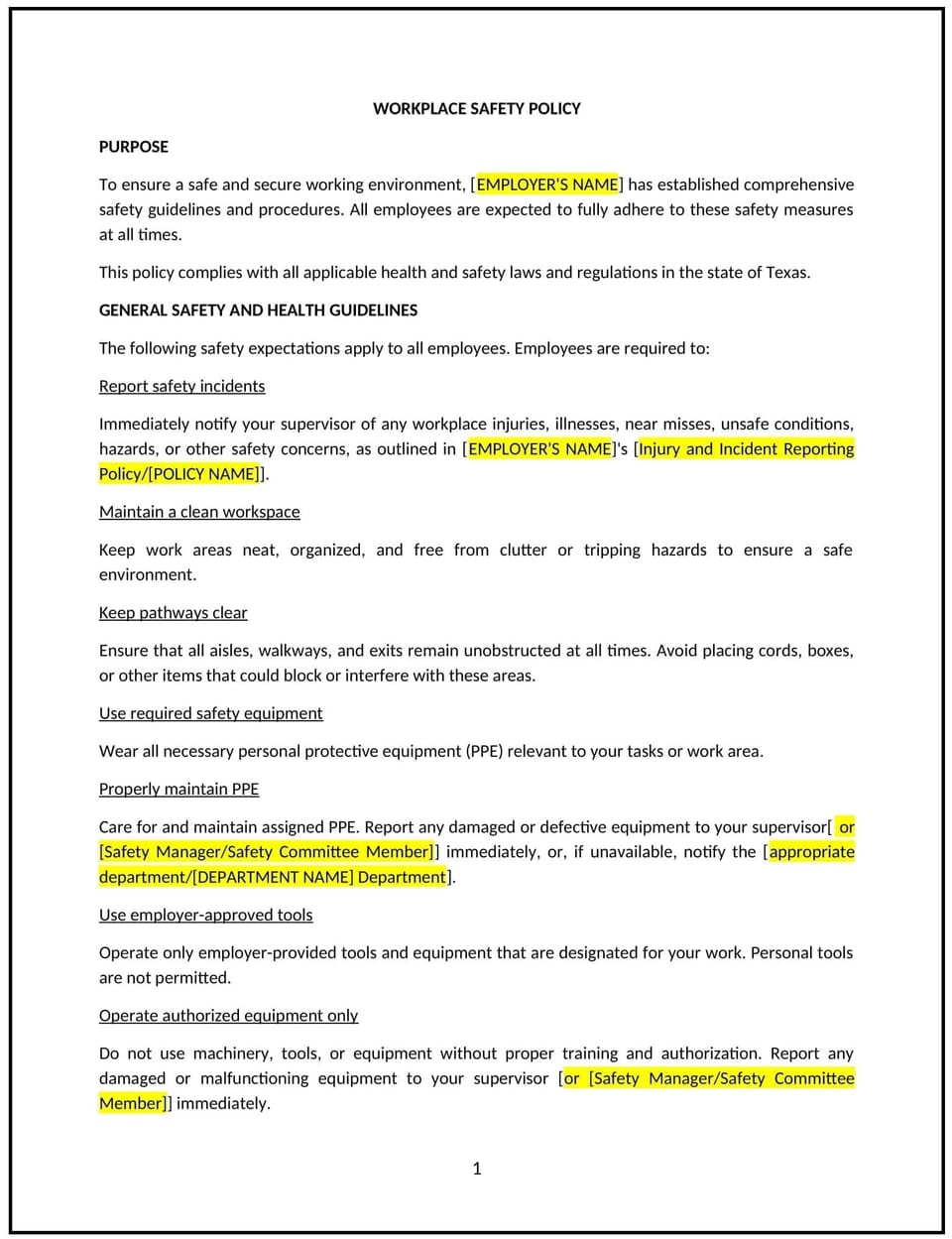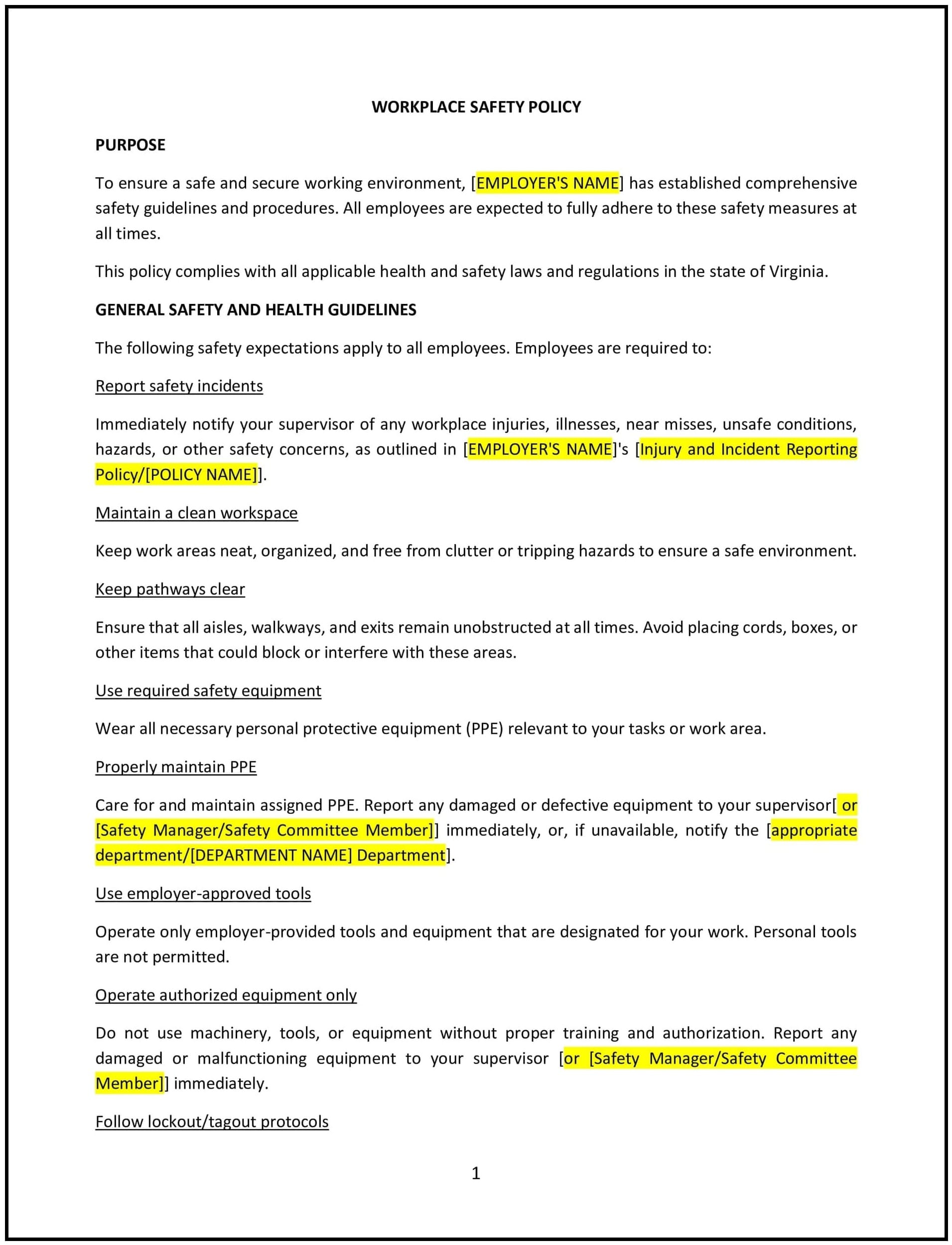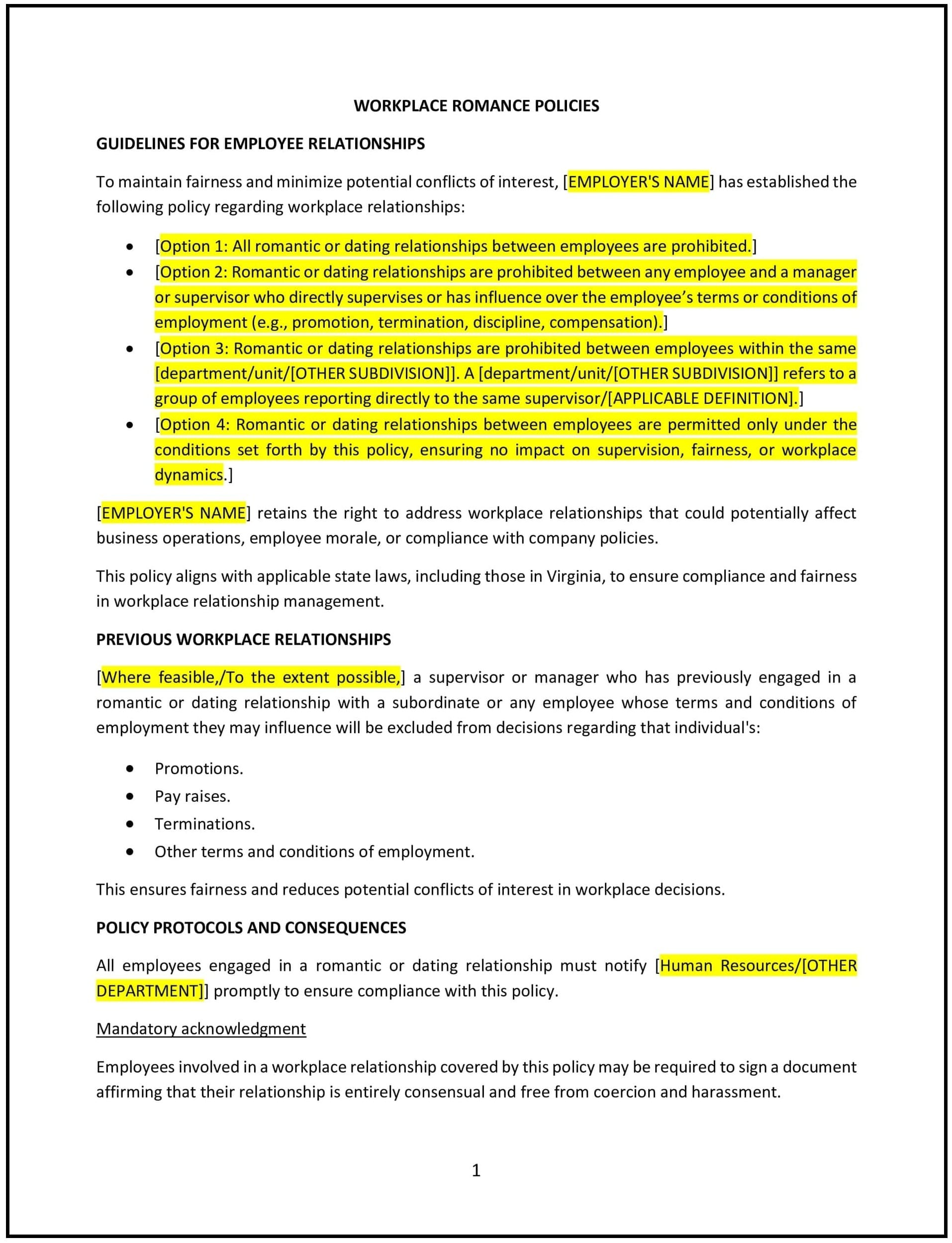Workplace safety policy (Texas): Free template

Workplace safety policy (Texas)
This workplace safety policy is designed to help Texas businesses create a safe and healthy work environment for all employees. The policy outlines the company’s commitment to workplace safety, the responsibilities of both employers and employees, and the procedures for reporting hazards, accidents, and unsafe conditions. It also includes the company's approach to complying with state and federal safety regulations.
By adopting this policy, businesses can reduce workplace accidents, ensure employee well-being, and comply with Texas and federal safety regulations.
How to use this workplace safety policy (Texas)
- Define workplace safety expectations: Clearly outline the company's commitment to maintaining a safe and healthy work environment. The policy should include general safety principles, such as adhering to safety standards, maintaining clean and organized workspaces, and using equipment properly.
- Set employee responsibilities: Specify the safety-related responsibilities of employees, such as following safety protocols, using personal protective equipment (PPE), reporting unsafe conditions, and participating in safety training.
- Set employer responsibilities: Outline the company’s role in providing a safe work environment, including ensuring that safety equipment is available, providing training, conducting safety inspections, and complying with Texas state laws and federal regulations.
- Implement a hazard reporting system: Establish a clear procedure for employees to report safety hazards, near-misses, or accidents. The policy should specify how and when employees should report unsafe conditions and how the company will respond to these reports.
- Provide safety training: Specify that all employees will receive safety training relevant to their roles and that the training will be updated regularly. This includes training on general safety practices, equipment use, and emergency procedures.
- Set emergency procedures: Define the emergency procedures for various scenarios, such as fires, medical emergencies, natural disasters, or workplace accidents. The policy should include evacuation plans, designated emergency exits, and protocols for contacting emergency services.
- Address accident investigation procedures: Outline the process for investigating workplace accidents or injuries, including how the incident will be reported, documented, and reviewed. Specify how corrective actions will be taken to prevent future accidents.
- Promote workplace wellness: The policy should encourage practices that enhance employee well-being, such as ergonomics, mental health resources, and programs that support a healthy work-life balance.
- Ensure compliance with safety laws: Specify that the company will comply with all applicable Texas state laws and federal regulations related to workplace safety, such as the Occupational Safety and Health Administration (OSHA) standards.
Benefits of using this workplace safety policy (Texas)
This policy offers several benefits for Texas businesses:
- Reduces workplace accidents: By clearly defining safety expectations and providing employees with the tools and training to work safely, businesses can significantly reduce accidents and injuries.
- Enhances employee well-being: A safe workplace is conducive to employee health and well-being, improving job satisfaction and reducing the likelihood of long-term health issues caused by unsafe working conditions.
- Increases productivity: A safer work environment leads to fewer disruptions caused by accidents, illnesses, or injuries, which can increase overall productivity.
- Supports legal compliance: By adhering to Texas and federal safety regulations, businesses reduce the risk of legal liabilities and fines associated with non-compliance.
- Boosts employee morale: When employees feel safe in their work environment, they are more likely to be engaged, satisfied, and motivated to contribute to the company’s success.
- Enhances company reputation: A business that prioritizes workplace safety enhances its reputation as a responsible and ethical employer, which can help attract and retain talent.
Tips for using this workplace safety policy (Texas)
- Communicate the policy clearly: Ensure that all employees are aware of the workplace safety policy, including how to report hazards, the safety procedures they must follow, and the emergency protocols in place.
- Provide regular safety training: Offer ongoing safety training to employees, ensuring that they are aware of any new safety risks or protocols. This training should be specific to the nature of the work and updated regularly.
- Conduct regular safety inspections: Regularly inspect the workplace for potential hazards and address any safety concerns promptly to prevent accidents.
- Foster a culture of safety: Encourage employees to speak up about safety concerns and recognize those who contribute to maintaining a safe work environment.
- Review and update regularly: Periodically review the policy to ensure it remains in line with Texas state laws, federal regulations, and evolving company needs. Update the policy as needed to address new safety challenges or risks.
Q: What are employees' responsibilities under this policy?
A: Employees are responsible for following safety protocols, using personal protective equipment (PPE), reporting hazards, participating in safety training, and taking part in emergency drills and procedures.
Q: How can employees report safety hazards or concerns?
A: Employees should report safety hazards immediately to their supervisor, the safety officer, or via the company’s designated reporting system. The policy should specify whether reports can be made anonymously or confidentially.
Q: What happens if an accident occurs at work?
A: The company will investigate all accidents and incidents, document the findings, and take corrective actions to prevent similar accidents in the future. Employees are expected to cooperate with the investigation process.
Q: Will employees be trained on workplace safety?
A: Yes, all employees will receive safety training that is relevant to their role. The policy should specify the types of training employees will receive and how often it will be updated.
Q: How should emergency situations be handled?
A: The policy should outline the emergency procedures, including evacuation plans, contact details for emergency services, and designated safety personnel to handle different types of emergencies (e.g., fires, medical emergencies, natural disasters).
Q: How often should this policy be reviewed?
A: The policy should be reviewed annually or whenever there are significant changes in Texas state laws, federal regulations, or company practices related to workplace safety.
This article contains general legal information and does not contain legal advice. Cobrief is not a law firm or a substitute for an attorney or law firm. The law is complex and changes often. For legal advice, please ask a lawyer.


